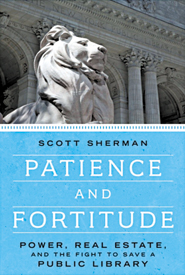Power, real estate, and the fight to save a public library

Scott Sherman. Brooklyn, NY & London, UK: Melville House Publishing, 2015; 224 pp; ISBN: 978-1-61219-429-5, $25.95 USD.
Review by James L. Turk
Strange and disturbing things have been happening to major libraries and archives as those responsible try to embrace the digital future.
Canada’s federal government shuttered unique departmental and research libraries, with reports of valuable collections being consigned to boxes in basements, tossed into dumpsters or opened to the public to scavenge through the remains. Library and Archives Canada has been diminished since 2009 as services were cut back, experienced librarians and archivists let go, important collections passed up, a moratorium placed on purchased acquisitions and inter-library loan halted.
There has been no shortage of protests. Both individuals and organizations have responded in every way they could imagine to stop what they saw was destructive behaviour causing irreversible harm to our intellectual heritage and our present and future research capacities.
The big question was why those who run major institutions would do what they are doing.
In his compelling new book, Patience and Fortitude: Power, Real Estate and the Fight to Save a Public Library, Scott Sherman tells the story of the fight over the trustees’ attempt to implement a plan that would devastate the New York Public Library — one of the world’s great libraries. The decade-long struggle was, according to Sherman, “a brawl about democracy, architecture, and, crucially, the role of books in the digital age.”
In telling the NYPL story, Sherman sheds light on what drives such ill-advised ventures and helps us see creative ways they can be opposed.
In many ways the New York Public Library is unique — a world-class public research library in the league of the Library of Congress, the Harvard University library system, the British Library and the Bibliothèque nationale de France. But years of public underfunding had left the NYPL in difficult shape. Its board of trustees, dominated by wealthy investment bankers and financiers, authorized selling some of the remarkable art in its collection and launching massive fund raising campaigns prior to forging their “Central Library Plan” in the years preceding the 2008 financial crisis.
The plan proposed cutting the heart out of its architecturally-unique main research library, starting with the removal of its seven levels of historic book stacks that supported the main reading room. The three million books were to be sent to a storage facility in New Jersey, and its grand reading room turned into a vast Internet café, while key branches were to be sold because they sat on valuable land.
The corporate mind-set driving the plan was apparent in the rationale written by Roger Hertog, an investment banker and trustee of the NYPL: “Among the Library’s most valuable assets is its large portfolio of real-estate holding … We’ve spent hours with consultants studying how best to use these assets in order to do as much as possible for our consumers and do it better than ever. We’ve studied the best practices of the very best companies with geographically diverse points of service, like Net Flix (sic), FedEx and Barnes & Noble.”
The 60-person NYPL board of trustees was a formidable group. Not only were there the investment bankers, billionaire philanthropists and real estate developers but also the former president of Harvard University (who became chair of the board in the midst of the fight), Harvard’s University librarian, and the editor of the New York Review of Books. The board had sold New York’s billionaire Mayor, Michael Bloomberg, on the plan, and it appeared unstoppable.
But then eminent French historian Joan Scott, from the Institute for Advance Study in Princeton, became aware of what was happening. She reached out to her friend Stanley Katz, an esteemed legal historian, who, like Scott, had relied on the NYPL in their formative student days. Scott started emailing friends and acquaintances with her concerns. Within days she had expressions of support from eminent writers and historians such as Mario Vargas Llosa, Salman Rushdie, Peter Carey, Ann Patchett, Ramachandra Guha and Natalie Z. Davis. Scott and her colleagues drew in other prominent scholars, writers, architects and artists; made creative use of social media; were joined by the New York Times architecture critic and engaged support from politicians in the New York Legislature. Several court actions were launched to stop the plan.
As opposition grew so did the determination of the trustees to push the plan through before Bloomberg’s term of office expired. Sherman tells the fascinating story of the no-holds-barred struggle: the “Books Not Billionaires” flash mobs, the more than 100,000 library users that wrote letters, a photo and commentary by a plan opponent on a popular photo blog that got 217,000 likes in 24 hours, appeals to the new mayor, and the duelling editorial positions of the city’s newspapers.
You’ll have to read Sherman to get the end of the story. If you do, you’ll enjoy a great yarn, but, even more, you will see a case study of how to resist the imposition of an inappropriate corporate approach to solving the very real problems of vital cultural institutions.
---------------------------------------------------------------
James L. Turk is former executive director of CAUT and distinguished visiting professor in the school of journalism at Ryerson University.